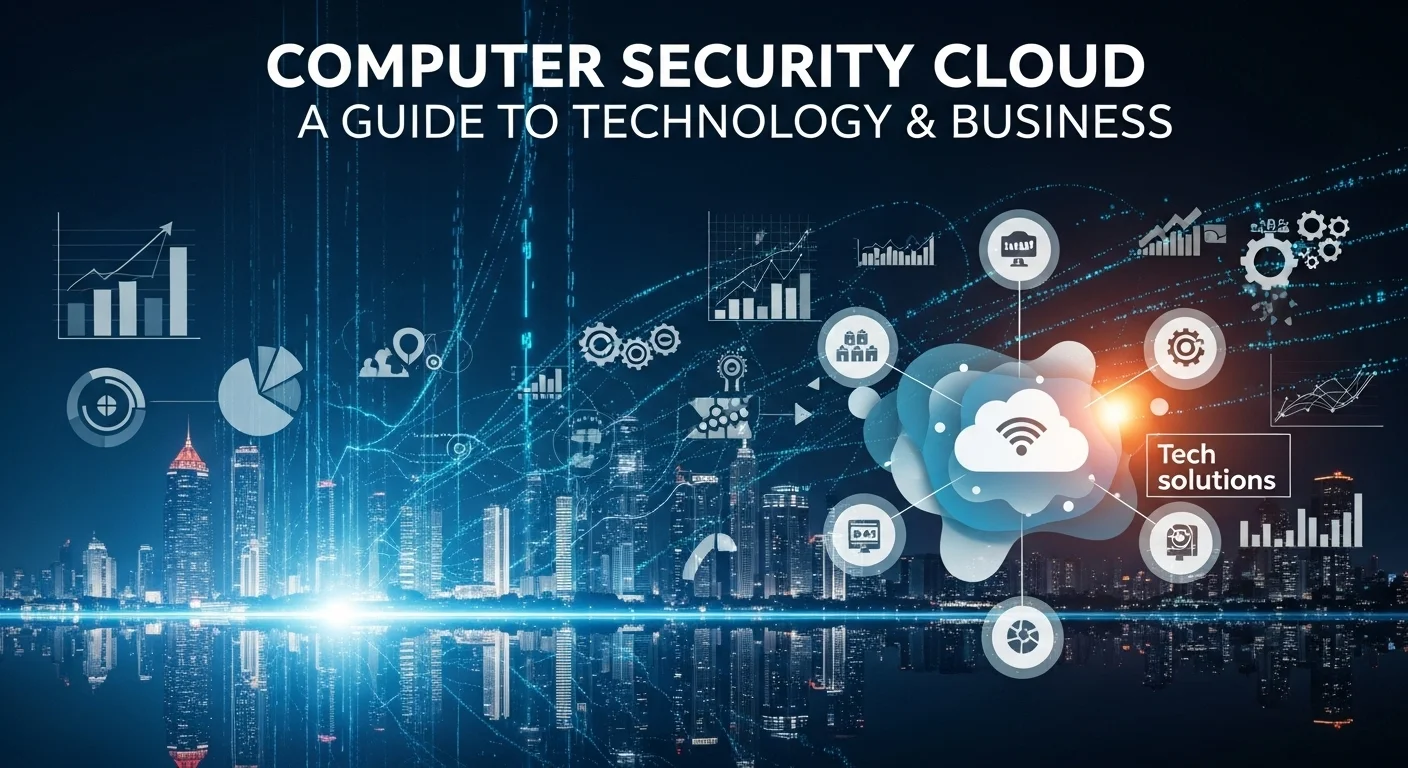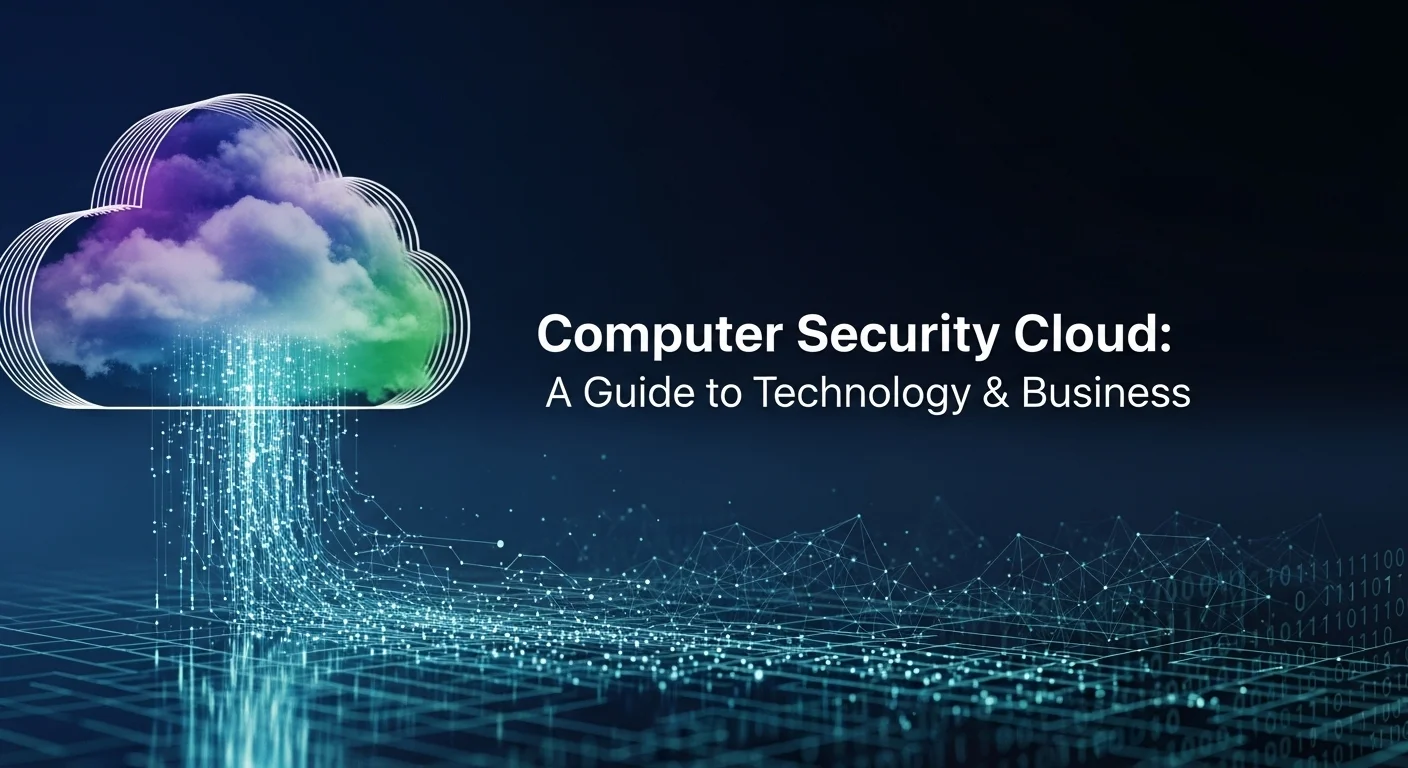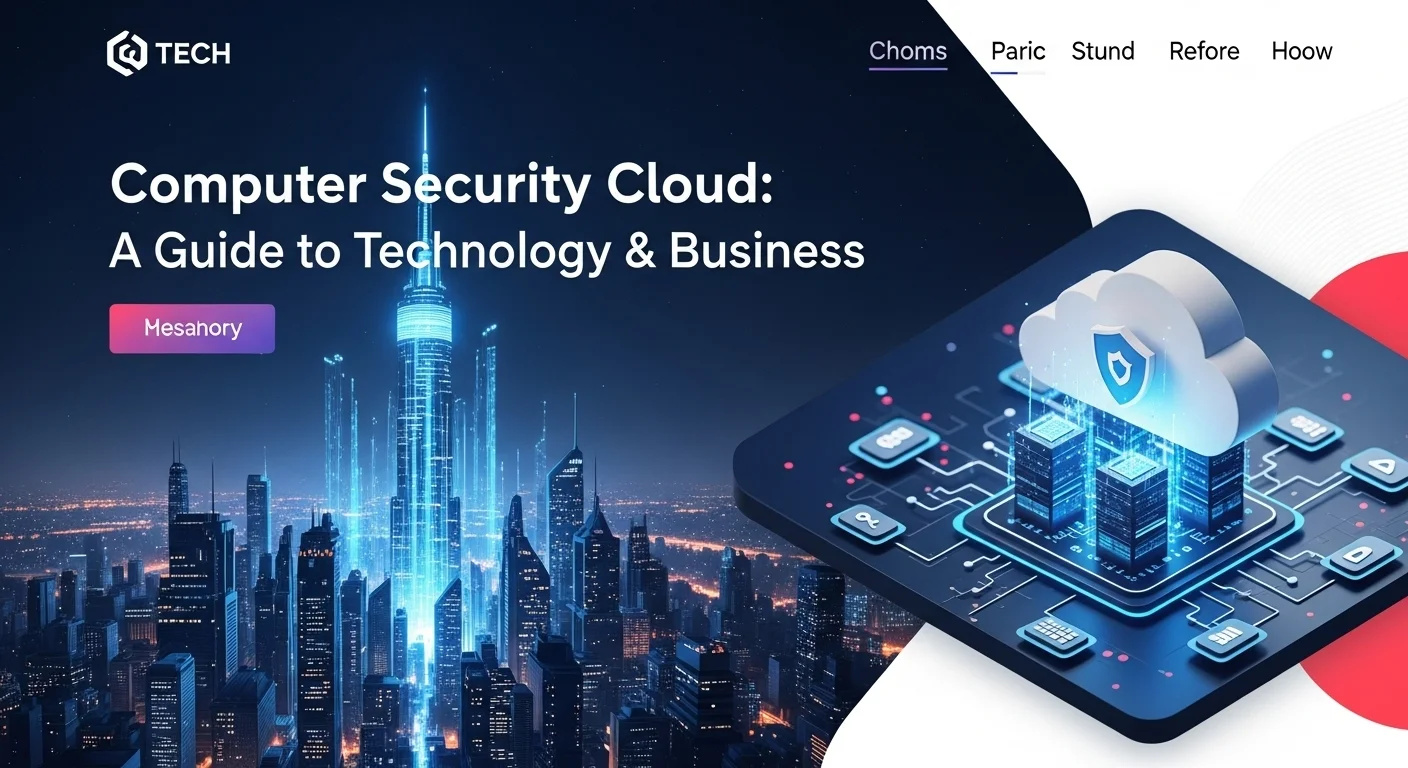Computer Security Cloud: A Guide to Technology & Business

Executive Summary
In the modern digital landscape, the migration to cloud services is not just a trend but a core business strategy. This article delves into the critical world of Computer Security Cloud, a paramount concern for any organization leveraging cloud technology. We will explore the fundamental concepts, from defining what cloud security entails to understanding its profound importance in protecting sensitive data and ensuring business continuity. This guide is designed for both business leaders and technology enthusiasts, providing a comprehensive overview of the challenges and solutions in the realm of cloud computing security. We will cover the shared responsibility model, which delineates the security obligations of cloud providers and their customers, and introduce the various cloud security services available. Furthermore, we will discuss how implementing robust information security in cloud computing not only mitigates risks like data breaches but also fosters innovation, scalability, and trust in an increasingly interconnected world. This article serves as an essential resource for navigating the complexities of securing your digital assets in the cloud.
Table of Contents
What is Computer Security Cloud and why is it important in Technology?
The term Computer Security Cloud, often used interchangeably with cloud security, refers to a comprehensive set of policies, technologies, controls, and services designed to protect data, applications, and infrastructure hosted in a cloud computing environment from cyber threats. As businesses and individuals increasingly rely on cloud services for everything from data storage and software delivery to complex computational tasks, the importance of robust security measures has become more critical than ever. The cloud environment, characterized by its on-demand services, scalability, and accessibility over the internet, introduces unique security challenges that differ significantly from traditional on-premises IT infrastructure. Understanding the nuances of cloud computing security is the first step for any organization looking to leverage the power of the cloud without exposing themselves to unacceptable risks. The fundamental goal is to safeguard data privacy, ensure data integrity, and maintain the availability of services, all while adhering to regulatory compliance requirements.
The importance of cloud security in technology cannot be overstated. In an era of digital transformation, data is one of the most valuable assets a company possesses. A security breach can lead to devastating consequences, including financial loss, reputational damage, legal penalties, and a loss of customer trust. The global average cost of a data breach is in the millions, making investment in security not just a technical necessity but a sound business decision. Strong cloud security in cloud computing enables businesses to confidently adopt innovative technologies like AI, machine learning, and big data analytics, which rely heavily on the cloud's processing power and storage capacity. It ensures that as companies scale their operations, their security posture can scale with them, providing a resilient and secure foundation for growth. Without adequate security, the very benefits of the cloud—agility, cost-efficiency, and collaboration—can be undermined by threats such as unauthorized access, data leakage, and denial-of-service attacks.
The Evolution from Traditional IT Security
To fully appreciate the scope of computer security in the cloud, it's helpful to contrast it with traditional IT security. In a conventional on-premises setup, an organization has complete physical control over its hardware. Security was primarily about building a strong perimeter—a digital fortress with firewalls, intrusion detection systems, and physical access controls. The network boundary was well-defined, and the focus was on protecting this perimeter from external threats. However, the cloud dissolves this traditional perimeter. Data and applications are distributed across various servers and data centers, accessible from anywhere with an internet connection. This distributed nature creates a much larger and more complex attack surface. The security focus must shift from protecting the perimeter to protecting the data and workloads themselves, wherever they reside. This is where the concept of information security in cloud computing becomes pivotal, emphasizing a data-centric approach. It requires a layered defense strategy, often referred to as 'defense in depth,' which includes robust identity and access management, continuous monitoring, and end-to-end encryption. The dynamic and ephemeral nature of cloud resources, such as virtual machines and containers that can be spun up and down in minutes, also demands a more automated and agile approach to security management than the static models of the past.
The Shared Responsibility Model: A Core Concept
A cornerstone of cloud security is the Shared Responsibility Model. This framework delineates the security obligations between the cloud service provider (CSP) like Amazon Web Services (AWS), Microsoft Azure, or Google Cloud Platform (GCP), and the customer. It's crucial to understand that migrating to the cloud does not mean outsourcing all security responsibilities. The CSP is typically responsible for the 'security *of* the cloud.' This includes protecting the physical infrastructure that runs all the cloud services, such as the hardware, software, networking, and facilities that run the CSP's services. On the other hand, the customer is responsible for 'security *in* the cloud.' This means the customer must secure their own data, applications, operating systems, and network configurations. The specific division of responsibility varies depending on the cloud service model being used:
- Infrastructure as a Service (IaaS): In this model, the CSP provides the basic computing infrastructure (servers, storage, networking). The customer has the most responsibility, including securing the operating system, middleware, applications, and data.
- Platform as a Service (PaaS): Here, the CSP manages the underlying infrastructure and the operating system. The customer is responsible for securing their applications and data deployed on the platform.
- Software as a Service (SaaS): With SaaS, the provider manages almost everything, delivering a complete software application. The customer's responsibility is typically limited to managing user access and securing their data within the application.
A common pitfall for organizations is misunderstanding this model, leading to dangerous security gaps. A staggering percentage of cloud security failures are attributed to the customer's misconfiguration or mismanagement of their responsibilities, not the provider's failure. Therefore, a deep understanding of this model is fundamental to building an effective strategy for cloud computing security.
Key Pillars of Computer Security Cloud
A comprehensive cloud security strategy is built on several key pillars that work together to create a robust defense. These pillars address various threat vectors and are essential for protecting the entire cloud ecosystem. The primary pillars include:
1. Identity and Access Management (IAM): IAM is the foundation of cloud security. It involves managing user identities and enforcing policies to ensure that only authorized individuals have access to the appropriate resources. This is often governed by the principle of least privilege, which dictates that users should only be granted the minimum level of access necessary to perform their job functions. Modern IAM solutions in the cloud include capabilities like multi-factor authentication (MFA), role-based access control (RBAC), and continuous authentication to prevent account hijacking and unauthorized access.
2. Data Protection and Encryption: Protecting data is paramount. This involves implementing strong encryption for data both 'at rest' (when stored on disks) and 'in transit' (as it moves across the network). Encryption renders data unreadable to unauthorized parties, making it a critical last line of defense. Beyond encryption, data protection involves data classification to identify sensitive information, data loss prevention (DLP) tools to prevent data exfiltration, and robust backup and recovery strategies to ensure business continuity in case of data loss.
3. Network Security: While the traditional perimeter has dissolved, network security remains vital. In the cloud, this involves creating virtual private clouds (VPCs), using security groups and network access control lists (ACLs) to segment networks and control traffic flow between resources. Advanced measures include deploying next-generation firewalls (NGFWs), intrusion detection and prevention systems (IDS/IPS), and implementing micro-segmentation to isolate workloads from each other, limiting the lateral movement of an attacker in case of a breach.
4. Threat Detection and Incident Response: No security system is impenetrable. Therefore, the ability to quickly detect threats and respond effectively is crucial. This involves continuous monitoring of cloud environments for suspicious activities, using Security Information and Event Management (SIEM) systems to aggregate and analyze logs, and having a well-defined incident response plan. Automation plays a key role here, enabling rapid response to common threats without manual intervention.
5. Governance and Compliance: Organizations, especially those in regulated industries like healthcare (HIPAA) or finance (PCI DSS), must ensure their cloud environments comply with relevant standards. Cloud security governance involves defining policies, procedures, and controls to manage risk and ensure compliance. Tools like Cloud Security Posture Management (CSPM) help automate the process of checking for misconfigurations and compliance violations, providing continuous visibility into the security posture of the cloud environment.
These pillars are supported by a growing ecosystem of cloud security services in cloud computing, offered both by the major CSPs and third-party vendors. These services provide specialized tools and expertise to help organizations manage the complexities of securing their cloud deployments. As we will explore further, the rise of security as a service in cloud computing offers businesses a flexible and scalable way to consume these advanced security capabilities. Embracing these foundational concepts is not just about preventing attacks; it's about building a resilient, trustworthy, and innovative technology stack that can power business success in the digital age.

Complete guide to Computer Security Cloud in Technology and Business Solutions
Navigating the intricate landscape of Computer Security Cloud requires a blend of technical acumen and strategic business planning. This guide provides a deep dive into the methods, resources, and comparisons necessary for implementing robust security solutions in a cloud environment. For any business leveraging cloud technology, a comprehensive understanding of these elements is not optional; it is essential for survival and growth. The core objective is to create a secure, resilient, and compliant cloud architecture that protects digital assets while enabling business agility. This involves a multi-faceted approach, encompassing everything from low-level technical controls to high-level governance strategies, ensuring that the cloud computing security framework is both effective and aligned with business goals.
Technical Methods for Securing the Cloud
Implementing effective cloud security hinges on a variety of technical methods and controls. These are the practical, hands-on measures that form the defensive layers of your cloud environment. A well-architected security plan will leverage a combination of these techniques to create a defense-in-depth strategy.
1. Advanced Encryption and Key Management: As previously mentioned, encryption is non-negotiable. Data must be encrypted both in transit, using protocols like TLS, and at rest, using algorithms like AES-256. However, the implementation details matter. For data in transit, it's crucial to enforce the use of the latest, most secure TLS versions and ciphers. For data at rest, CSPs offer various encryption options. Server-side encryption (SSE) means the CSP manages the encryption keys. Client-side encryption involves the customer encrypting data before sending it to the cloud, giving them full control over the keys. The management of these cryptographic keys is a critical aspect of information security in cloud computing. Services like AWS Key Management Service (KMS) or Azure Key Vault provide secure, centralized management of encryption keys, allowing for controlled usage, rotation, and auditing. For highly sensitive data, organizations might use a dedicated Hardware Security Module (HSM) in the cloud to ensure keys are never exposed in software.
2. Granular Identity and Access Management (IAM): IAM is more than just usernames and passwords. Modern cloud IAM frameworks enable highly granular control. Role-Based Access Control (RBAC) is a standard practice where permissions are assigned to roles rather than individual users, simplifying management. For instance, a 'Developer' role might have permission to deploy code but not to delete a production database. The principle of least privilege should be strictly enforced. Furthermore, advanced IAM includes features like Multi-Factor Authentication (MFA), which adds a critical layer of security against credential theft. Context-aware access policies can also be implemented, which evaluate factors like user location, device health, and time of day before granting access. Regular access reviews and automated tools to identify and remove excessive permissions are vital for maintaining a secure IAM posture.
3. Sophisticated Network Security Controls: Cloud network security moves beyond simple firewalls. Virtual Private Clouds (VPCs) or Virtual Networks (VNets) create logically isolated sections of the public cloud, giving organizations a private, controlled space. Within these VPCs, security groups (stateful firewalls) and network ACLs (stateless firewalls) control traffic at the instance and subnet level, respectively. A key technique is micro-segmentation, which involves dividing the network into small, isolated segments down to the individual workload level. This drastically limits an attacker's ability to move laterally within the network if one component is compromised. Additionally, services like Web Application Firewalls (WAF) are essential for protecting web applications from common exploits like SQL injection and cross-site scripting (XSS). Many organizations also deploy Intrusion Detection/Prevention Systems (IDS/IPS) and perform deep packet inspection to monitor for and block malicious network activity.
4. Secure Configuration and Vulnerability Management: Misconfigurations are a leading cause of cloud data breaches. It is imperative to establish secure configuration baselines for all cloud resources. This can be enforced using Infrastructure as Code (IaC) tools like Terraform or AWS CloudFormation, where security policies are embedded directly into the deployment templates. Cloud Security Posture Management (CSPM) tools continuously scan cloud environments to detect misconfigurations, compliance violations, and security risks, providing automated alerts and sometimes remediation. Complementing this is vulnerability management. Cloud Workload Protection Platforms (CWPP) are designed to secure workloads (like virtual machines, containers, and serverless functions) by scanning for vulnerabilities in the operating system and application code, providing runtime protection, and ensuring integrity.
Business Techniques for Cloud Security Implementation
Technology alone is not enough. A successful cloud security in cloud computing program must be integrated into the business's fabric through strategic techniques and processes.
1. Adopting a 'Security by Design' Culture: Security should not be an afterthought or a final step before deployment. It must be integrated into the entire lifecycle of application development and infrastructure management. This is the core idea behind DevSecOps, a cultural shift that embeds security practices into the DevOps pipeline. Security checks, vulnerability scans, and policy enforcement are automated and performed at every stage, from coding and building to testing and deployment. This approach helps identify and fix security issues early, when they are easier and cheaper to resolve.
2. Comprehensive Employee Training and Awareness: The human element is often the weakest link in the security chain. Employees can inadvertently cause security incidents through phishing attacks, weak passwords, or mishandling of data. A continuous security awareness program is essential. This should include regular training on topics like identifying phishing emails, secure data handling practices, and the importance of following security policies. Phishing simulations can be a powerful tool to test and reinforce this training. A well-informed workforce acts as a human firewall, providing an additional layer of defense.
3. Developing a Robust Incident Response Plan: Despite best efforts, security incidents can happen. A well-documented and regularly tested incident response (IR) plan is critical to minimizing damage and ensuring a swift recovery. The plan should clearly define roles and responsibilities, communication channels, and the steps to be taken for different types of incidents (e.g., data breach, DDoS attack, malware infection). Cloud services can aid in this, with automated playbooks that can, for example, automatically isolate a compromised instance or revoke credentials. Regular drills and tabletop exercises ensure that the team is prepared to execute the plan effectively under pressure.
Available Resources and Comparisons
The market for cloud security services in cloud computing is vast and varied. Organizations have a wide array of resources at their disposal, from native tools provided by CSPs to specialized third-party solutions.
Comparing Major Cloud Providers (AWS, Azure, GCP):
- AWS: Offers a mature and extensive portfolio of security services, including AWS Shield for DDoS protection, AWS WAF, Amazon GuardDuty for threat detection, and AWS Security Hub for centralized security posture management. Its IAM service is powerful but can be complex to manage at scale.
- Microsoft Azure: Leverages its deep enterprise experience. Microsoft Defender for Cloud is a comprehensive solution that combines CSPM and CWPP capabilities. Azure Active Directory is a market-leading IAM solution, particularly for organizations already invested in the Microsoft ecosystem.
- Google Cloud Platform (GCP): Often praised for its strong default security posture and robust network security capabilities. Its 'BeyondCorp' model for zero-trust security is highly influential. GCP's security offerings are rapidly expanding, with strong capabilities in data analytics and machine learning for threat detection.
Security as a Service (SECaaS) in Cloud Computing: Beyond the big three CSPs, a thriving market exists for security as a service in cloud computing. SECaaS is a model where a provider offers security services on a subscription basis. This can be highly cost-effective, providing access to specialized expertise and advanced technology without significant upfront investment. Examples include:
- Managed Detection and Response (MDR): Outsourced security operations centers that provide 24/7 monitoring and threat hunting.
- Cloud Access Security Brokers (CASB): Tools that sit between cloud users and cloud applications to enforce security policies, monitor activity, and prevent risky behavior.
- Data Loss Prevention (DLP) as a Service: Services that monitor and control endpoint activities to prevent sensitive data from leaving the organization's control.
Choosing the right mix of native CSP tools and third-party SECaaS solutions depends on the organization's specific needs, budget, in-house expertise, and multi-cloud strategy. A successful approach often involves integrating the best-of-breed tools into a unified security framework, creating a resilient and adaptive defense system for the complex world of cloud technology.

Tips and strategies for Computer Security Cloud to improve your Technology experience
Mastering Computer Security Cloud is an ongoing journey, not a one-time destination. As cloud technologies evolve and cyber threats become more sophisticated, businesses must adopt dynamic and forward-thinking strategies to protect their digital estates. This section provides practical tips, advanced strategies, and best practices to enhance your technology experience by building a resilient and proactive security posture. By focusing on continuous improvement, automation, and strategic alignment, organizations can transform their cloud computing security from a mere defensive necessity into a business enabler that fosters trust, innovation, and a competitive edge.
Best Practices for a Secure Cloud Foundation
Adhering to established best practices is the cornerstone of any effective cloud security program. These practices, when consistently applied, significantly reduce the attack surface and mitigate the most common risks.
1. Embrace a Zero Trust Architecture: The traditional 'trust but verify' model is obsolete. A Zero Trust approach operates on the principle of 'never trust, always verify.' This means that no user or device, whether inside or outside the network, is trusted by default. Every access request must be explicitly authenticated, authorized, and encrypted before being granted. Implementing Zero Trust involves strong identity verification (MFA is a must), micro-segmentation to limit network access, and enforcing least privilege access to all resources. This model dramatically reduces the risk of lateral movement by attackers and contains the blast radius of any potential breach.
2. Automate Security and Compliance: In the dynamic, large-scale environment of the cloud, manual security management is unfeasible and error-prone. Automation is key. Use Infrastructure as Code (IaC) to define and deploy infrastructure and security controls in a repeatable, documented manner. This ensures consistency and allows security policies to be version-controlled and peer-reviewed like any other code. Leverage Cloud Security Posture Management (CSPM) and Cloud Workload Protection Platform (CWPP) tools for continuous, automated monitoring. These tools can automatically detect and alert on misconfigurations, vulnerabilities, and compliance drifts, and in some cases, can perform automated remediation, such as correcting an overly permissive firewall rule. This proactive automation is central to maintaining strong information security in cloud computing.
3. Maintain Rigorous Logging and Monitoring: You cannot protect what you cannot see. Comprehensive logging and monitoring are critical for threat detection, incident response, and forensic analysis. Ensure that logging is enabled for all relevant cloud services, including API calls (e.g., AWS CloudTrail), network traffic (e.g., VPC Flow Logs), and application-level events. These logs should be centralized in a Security Information and Event Management (SIEM) system for correlation and analysis. Use threat intelligence feeds to enrich this data and set up automated alerts for suspicious patterns of activity. Regular review of these logs and alerts is essential for identifying potential threats before they escalate.
4. Implement a Strong Data Governance and Classification Framework: Not all data is created equal. A robust data governance strategy starts with data discovery and classification. You need to know what data you have, where it resides, and how sensitive it is. Once classified, you can apply appropriate security controls. For example, highly sensitive data may require stricter access controls, stronger encryption, and more granular logging. Data Loss Prevention (DLP) tools can then be configured with policies based on this classification to prevent the unauthorized exfiltration of sensitive information. This ensures that your security efforts are focused on protecting your most critical assets.
Advanced Business and Technology Strategies
Beyond the foundational best practices, forward-looking organizations employ advanced strategies to stay ahead of the curve and derive maximum value from their security investments.
1. Leverage AI and Machine Learning for Threat Intelligence: The sheer volume of security data generated in the cloud makes it impossible for human analysts to review everything. Artificial Intelligence (AI) and Machine Learning (ML) are becoming indispensable tools for modern cloud security in cloud computing. AI-powered security platforms can analyze vast datasets in real-time to identify anomalous behaviors that may indicate a sophisticated attack. They can detect subtle patterns, reduce false positives, and predict potential threats, allowing security teams to focus their attention on the most critical issues. Many modern cloud security services in cloud computing, such as Amazon GuardDuty or Microsoft Defender for Cloud, have these capabilities built-in.
2. Integrate Security into Financial Operations (FinOps): Cloud security and cost management are intrinsically linked. A compromised account can lead to massive, unexpected bills from activities like crypto-mining. Conversely, inefficiently deployed security tools can inflate costs. The practice of FinOps, which brings financial accountability to the variable spend model of the cloud, should include security as a key consideration. Security teams should work with FinOps practitioners to identify cost-effective security solutions, monitor for cost anomalies that might indicate a security breach, and ensure that security controls are implemented efficiently. This holistic view ensures that the security posture is not only strong but also financially sustainable.
3. Plan for Business Continuity and Disaster Recovery (BCDR): Robust security includes the ability to recover from a disruptive event, whether it's a cyberattack, a system failure, or a natural disaster. A comprehensive BCDR plan is essential. The cloud offers powerful tools for this, such as the ability to back up data across multiple geographic regions and automate the failover of applications to a secondary site. Regularly test your disaster recovery plan through drills and simulations to ensure it works as expected and to identify any weaknesses. A well-tested BCDR plan is a critical component of business resilience and a key benefit of a mature cloud strategy.
Exploring Quality External Resources
Staying informed is crucial in the fast-paced world of cloud security. Engaging with the community and following authoritative sources provides valuable insights into new threats, technologies, and best practices. A highly recommended resource is the Cloud Security Alliance (CSA). The CSA is a non-profit organization dedicated to defining and raising awareness of best practices to help ensure a secure cloud computing environment. They provide a wealth of research, certification programs (like the Certificate of Cloud Security Knowledge - CCSK), and tools, including the widely-used Cloud Controls Matrix (CCM), which is a cybersecurity control framework for cloud computing. Engaging with resources like the CSA helps professionals and businesses stay at the forefront of security as a service in cloud computing and broader security trends.
In conclusion, achieving a high level of computer security in the cloud is a multifaceted endeavor that blends robust technology, smart strategy, and a culture of continuous vigilance. By implementing these tips and strategies, from embracing a Zero Trust mindset to leveraging AI and planning for disaster recovery, businesses can not only protect themselves from an ever-evolving threat landscape but also build a secure and resilient technology foundation that confidently supports their long-term goals.
Expert Reviews & Testimonials
Sarah Johnson, Business Owner ⭐⭐⭐
The information about Computer Security Cloud is correct but I think they could add more practical examples for business owners like us.
Mike Chen, IT Consultant ⭐⭐⭐⭐
Useful article about Computer Security Cloud. It helped me better understand the topic, although some concepts could be explained more simply.
Emma Davis, Tech Expert ⭐⭐⭐⭐⭐
Excellent article! Very comprehensive on Computer Security Cloud. It helped me a lot for my specialization and I understood everything perfectly.



